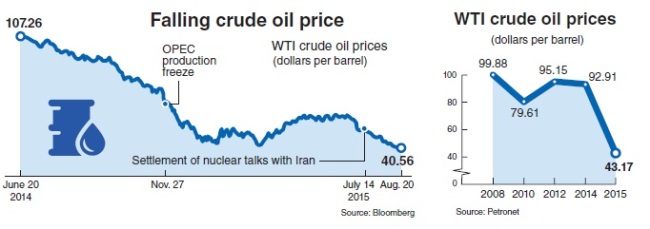Faced with fluctuating oil prices that have led to a renewed drop in refining margins, South Korean oil refiners are geared for a major downturn in profits in the third quarter.
An oversupply of oil coupled with slowing demands from key consumers like China have been driving down the world’s oil prices to record-lows, with the U.S. benchmark West Texas Intermediate crude hitting a six-year-low, closing below $40 a barrel on Aug. 21, amid an expected hike in stockpiles from the U.S. and the Middle East.
A renewed drop in crude prices has signaled bad news for oil refiners around the world, including those in South Korea that depend on cracking margins to reap profits from its refined oil products, most of which are exported overseas.
The country’s major refiners, SK Innovation, GS Caltex, S-Oil and Hyundai Oilbank, are set to post low profits stemming from hefty inventory valuation losses for crude purchased several months ahead for delivery, in the latter half of this year.
“Korean refiners are expected to post poor performances in the third quarter,” said Yuanta Securities analyst Hwang Kyu-won. “Margins will improve only if global oil demands stabilize and the oversupply of oil in the market comes under control.”

Cracking margins, or crack spreads, refer to the difference between what refiners pay for the crude oil they purchase and the price of their final products sold in the market.
Marked by dollars per barrel, the margin determines the profits that refiners can reap by processing one barrel of crude into petroleum products.
Singapore gross refining margins that had hovered above $9 in the first half of the year almost halved to less than $5 in July, ushering Korean refiners to brace themselves for a steep plunge in profits in the third quarter.
Though the exact figures differ across companies, a margin of around $5 is widely perceived as the breakeven point for Korean refiners. Moreover, around 50 billion won ($42 million) and 80 billion won are compromised for every $1 drop in margins, according to industry figures.
Poor margins of between $3 and $6 had pushed the Korean refining sector into the red last year, when local refiners posted record-low deficits of hundreds of billions of won.
Meanwhile, refiners had also swung back to recovery in the first half of this year on the back of improved cracking margins, increased demands for petrochemical products and relatively stable oil prices.
Industry watchers say that low oil prices are most likely here to stay, as Iran, which possesses the world’s fourth-largest proven crude oil reserves, returns to the market and the U.S. steps up its shale production.
Faced with poor margins stemming from unstable crude prices, coupled with an oversupply of oil products around the world that falls short of global demands, Korean refiners have been pushed to reform their business portfolios to establish new profit routes.
SK Innovation, the country’s top refiner, has been quickly undertaking major structural changes in a bid to retain its competitive edge amid continued instability in the global refining sector.
Such efforts include cutting costs by diversifying its crude supply, producing more exclusive, high-value petroleum products, selling off its nonessential assets, bolstering partnerships with overseas partners as well as channeling fresh investments into its fledgling car battery business, among others.
GS Caltex has been focusing on diversifying the range of its crude suppliers to include countries like Mexico and the United States, as well as those in West Africa, in a bid to reduce its reliance on oil from the Middle East.
The company has also begun constructing a 50 billion won plant to produce biobutanol, an alternative, renewable fuel eyed by industry watchers as a key future energy source.
Meanwhile, S-Oil has invested 5 trillion won into building its Olefin Downstream Complex and the Residue Upgrading Complex in Ulsan over the next three years.
Upon completion, the facilities will turn low-quality crude into high-value gasoline and olefins, bringing in fresh profits for the company.
To reduce inventory valuation losses, Hyundai Oilbank has been pulling forward its export agendas to reduce its crude stockpile volumes down to around 80 to 85 percent of normal levels.
At Hyundai Oilbank’s Daesan refinery, engineer meetings are reportedly held every two weeks to draw up and discuss measures to improve the efficiency of its production facilities and reduce related costs.
By Sohn Ji-young (
jys@heraldcorp.com)





![[Exclusive] Hyundai Mobis eyes closer ties with BYD](http://res.heraldm.com/phpwas/restmb_idxmake.php?idx=644&simg=/content/image/2024/11/25/20241125050044_0.jpg)
![[Herald Review] 'Gangnam B-Side' combines social realism with masterful suspense, performance](http://res.heraldm.com/phpwas/restmb_idxmake.php?idx=644&simg=/content/image/2024/11/25/20241125050072_0.jpg)

